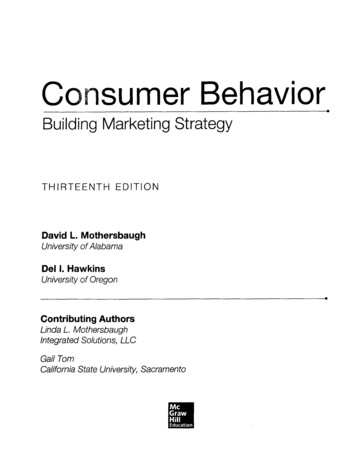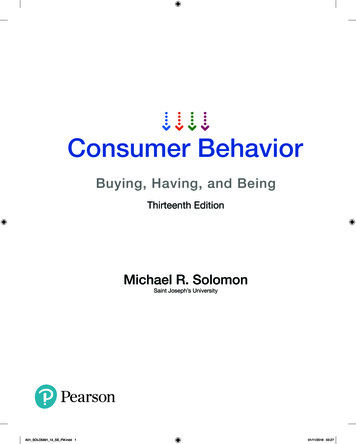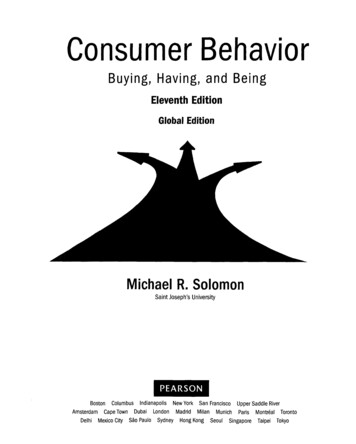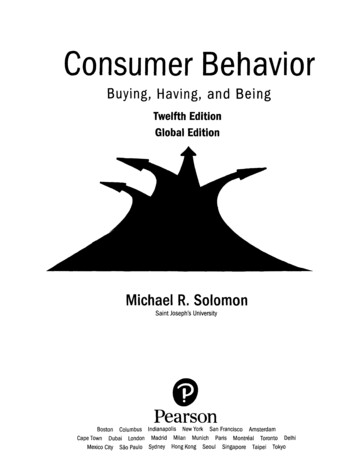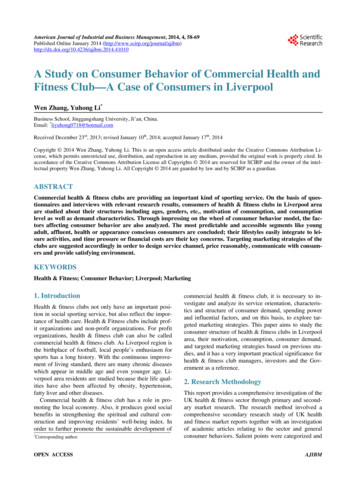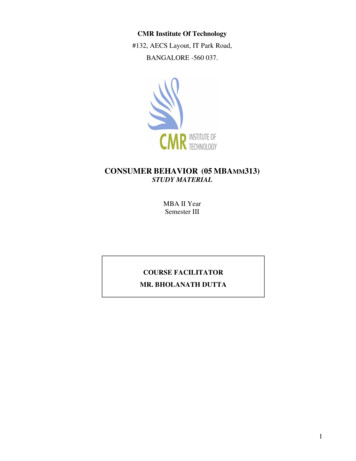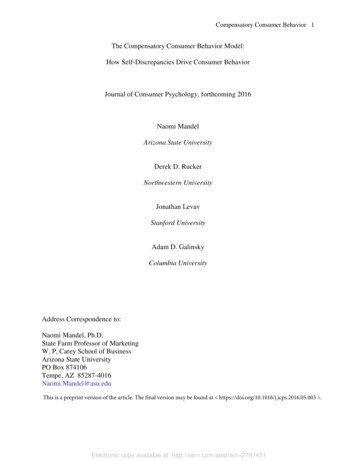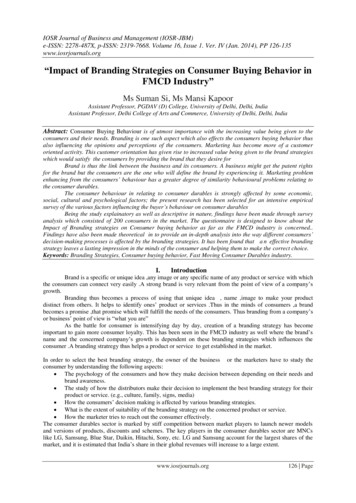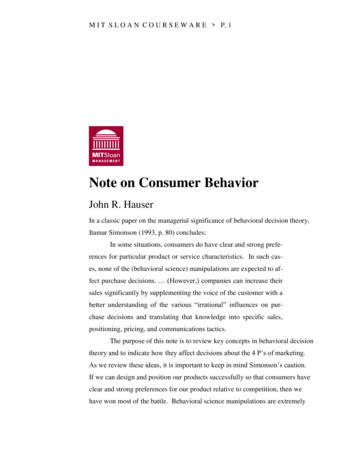
Transcription
M I T S L O A N C O U R S E W A R E P. 1Note on Consumer BehaviorJohn R. HauserIn a classic paper on the managerial significance of behavioral decision theory,Itamar Simonson (1993, p. 80) concludes:In some situations, consumers do have clear and strong preferences for particular product or service characteristics. In such cases, none of the (behavioral science) manipulations are expected to affect purchase decisions. (However,) companies can increase theirsales significantly by supplementing the voice of the customer with abetter understanding of the various ―irrational‖ influences on purchase decisions and translating that knowledge into specific sales,positioning, pricing, and communications tactics.The purpose of this note is to review key concepts in behavioral decisiontheory and to indicate how they affect decisions about the 4 P’s of marketing.As we review these ideas, it is important to keep in mind Simonson’s caution.If we can design and position our products successfully so that consumers haveclear and strong preferences for our product relative to competition, then wehave won most of the battle. Behavioral science manipulations are extremely
M I T S L O A N C O U R S E W A R E P. 2important, but they go hand-in-hand with a basic understanding of customerwants and needs.Lens Model RevisitedWe first saw the lens model (Figure 1) in the ―Note on Product Development‖ where we learned that the most profitable products are those that customers perceive as best. In product development our goal is to identify customer needs and to design the product and marketing tactics so that the customerperceives that the product fulfills the customers needs. The basic lessons of thelens model carry over to the study of consumer behavior. Customers see theworld through the lens of perceptions and their preferences are based on thoseperceptions. Choice is dependent upon customer preferences, but other influences, such as availability and perceived price, also influence the products thatcustomers choose.Product FeaturesPerceptionsPreferencesPsycho-social cuesAvailability,PriceChoiceFigure 1. Review of the “Lens” ModelIn this note we explore how perceptions are affected by context andframing, how preferences might be constructed based on the choices available,and how choices may, at first, seem ―irrational.‖ In other words, consumer behavior is not a simple, constant process. Each and every arrow in Figure 1 is influenced by context. As managers we can influence that context with the 4 P’sof marketing. I put ―irrational‖ in quotes because (1) there is good scientificevidence that seemingly irrational decisions actually work quite well in most of
M I T S L O A N C O U R S E W A R E P. 3the situations faced by consumers and (2) who is to define what is irrational ifthe customer is satisfied with the outcome.Non-compensatory and Other Constructed ProcessesMany of students use personal digital assistants (PDAs). On the websiteof our MIT’s approved supplier, GovConnection, we find 97 PDAs from whichwe can choose. Local retailers also have moderately broad product lines – 21 atCircuit City, 25 at Staples, 27 at Microcenter, and 33 at CompUSA. On websites and in retail stores sellers provide tools to simplify PDA choice for consumers. For example, Staples, CompUSA, and Microcenter structure the choicesets (e.g., Palm-OS vs. Windows CE) while all retailers and websites encourageconsumers to self-organize the choice sets by operating system, brand, price, orother features. Figure 2 reproduces a webpage from CompUSA.Figure 2. PDA’s From CompUSAFew consumers take the time to evaluate 33 PDAs, let alone 97 PDAs.CompUSA’s website helps consumers narrow that search quickly. But does thevery act of providing categories influence consumer behavior? Before we answer that question, it is worthwhile to consider whether consumers naturallyprocess information by categories.
M I T S L O A N C O U R S E W A R E P. 4Economic theory introduced the concept of utility functions and indifference curves. For example, a consumer faced deciding among PDAs with different sizes and different prices would trade off size with price. Assumingsmall is better, a consumer may be willing to pay more for a smaller PDA. Wecall this model of consumer behavior a compensatory model because one characteristic, size, can compensate for another characteristic, price. A compensatory model assumes that consumers tradeoff features such as size, keyboardlayout, operating system, brand, and price to choose the PDA that is best forthem.However, think of the poor consumer who has to gather informationabout the characteristics for all 97 PDAs, put them in a spreadsheet, assign someweights to each characteristic, and make a choice. I am willing to bet that veryfew 15.810 students constructed such a spreadsheet before choosing a PDA (orcell phone).It is more common for consumers to use a two-stage process of, first,screening the large set of PDAs quickly and then, second, choosing carefullyamong the smaller set of screened PDAs. Such two-stage processes are common and rational if we consider search and evaluation costs. As a thought experiment, image a consumer who screens 97 PDAs to a smaller set of 6 PDAs andthen chooses the best of the smaller set. For this consumer, a two-stage processmight identify the best PDA for that consumer. If the best PDA is overlooked,the PDA that the consumer ends up purchasing might be almost as good (forthat consumer) as the PDA that was overlooked. In other words, the loss in utility (utility of best PDA minus utility of chosen PDA) might be quite small.However, the two-stage process is quicker and easier. It is rational for the consumer if the evaluation and search costs saved are greater than the slight loss inutility from using the two-stage screen-then-choose process.Once we accept that a two-stage process might be best, on average, forthe consumer, we can ask how the first stage operates. Review Figure 2. CompUSA is assuming that the consumer first chooses either operating system (OS),brand, or price range. This is one example of a ―lexicographic‖ process. Lex-
M I T S L O A N C O U R S E W A R E P. 5icography is the process of compiling a dictionary. In English dictionaries,words are sorted in alphabetical order. All the ―a‖ words come before the ―b‖words; all the ―aa‖ words come before all the ―ab‖ words, etc. The word, ―babble,‖ would not come before the word, ―azygous,‖ even though babble has lotsof letters from the beginning of the alphabet and azygous from the end of the alphabet. The ―a,‖ ―e,‖ and two ―b‖’s in babble do not compensate for the ―z,‖―y,‖ ―o,‖ and ―u‖ in azygous. Azygous begins with an ―a‖ and that sets it aheadof babble.In an analogy to a dictionary sort order, consumers might sort productslexicographically by the aspects of the features. For example, they might limitthemselves to a PDA under 200. No amount of features would convince themto move up to a 500 PDA. In other words, all low-priced PDAs are sorted asbeing preferred to all high-priced PDAs. The next feature in the lexicographicorder might be OS. The consumer would sort PDAs as {low-price, Palm},{low-price, Pocket PC}, {high-price, Palm}, {high-price, Pocket PC}. If thereare enough low-priced Palm-OS PDAs, these might form the consumers consideration set. The consumer might then choose only from his or her considerationset.There is evidence that lexicographic processes might be rational in situations that we normally encounter. Two German researchers devised a simpletest.1 They asked consumers if they could identify which of two German citieswas larger. Consumers tended to address this task lexicographically – if I’veheard of it, it must be larger; if I’ve heard of both cities, the larger city is thecity that is a state capital; if I’ve heard of both and neither is a state capital, thelarger city is the city that has a soccer team in the national league; etc. Moreimportantly, they found that lexicographic decision rules did extremely well inclassifying German cities. They also found that these heuristics were often better for the German-city task than a compensatory process – weighing all features of the cities to come up with a score. Their argument is that, for the tasksthat consumers face everyday, lexicographic processes do quite well.1Gigerenzer and Goldstein (1996).
M I T S L O A N C O U R S E W A R E P. 6As an illustration, we tested lexicographic processing on a survey to15.810 students last year. Each student was asked to choose from a set of 32SmartPhones that varied on 16 aspects. There were no constraints on how thechoice was made. Of these students, 92% used a non-compensatory (lexicographic) process. The key aspects that they used are shown in Table 1. For example, almost 50% of the students simply rejected any SmartPhone priced at 499 or above. Another 32% limited their search to flip SmartPhones andanother 29% limited their search to small SmartPhones. Were this a nationalsample, the information would be critical to (1) the design of SmartPhones, (2)the design of retail space, (3) the design of websites, and (4) any advertising orcommunications strategy.Table 2: Top Lexicographic Aspects for SmartPhonesAspectAccept/RejectPercent of SamplePrice – 499Reject49.2%FlipAccept32.0%SmallAccept29.4%Price – 299Reject19.8%KeyboardAccept17.3%Price – 99Accept14.5%Constructed ProcessesOne we accept that consumers might use heuristic processes to evaluateproducts and services, we must recognize that these processes might be contextdependent. For example, if there are only four PDAs, it may not be necessaryfor the consumer to use a lexicographic process to screen those PDAs. Indeed,when we gave 15.810 students only 16 SmartPhones, the percent of students using a lexicographic process decreased from 92% to 72%. This is a general result – non-compensatory processes are more likely when the number of alternatives is large. In other words, if the manufacturer, retailer, or website offers theconsumer more alternatives, the consumer is more likely to use a lexicographic
M I T S L O A N C O U R S E W A R E P. 7process. In these situations it is critical for the manager to know which aspectsare being used by consumers to screen the large set of products.The size of the choice set is only one influence on the process by whichconsumers choose. The key scientific idea is that preferences are not immutable, but, instead, are constructed as the consumer is asked to make a decision.Decisions may be different depending upon the decision context. Studentsfaced with 32 PDAs may make a difference choice than those faced with 16PDAs, even if their first choice from 32 is in the set of 16. In an excellent review of the literature, Profs. Bettman, Luce, and Payne of Duke University suggest that:2 if the consumer is limited in processing capability, say by time pressure,then the consumer is more likely to construct his or her preferences, if choice tasks are more complex, consumers are more likely to use heuristic processing rules such as the lexicographic rule describe above, preferences are more stable if the choice task is simpler, problem difficulty matters:o the number of alternatives has a bigger effect of simplificationthan the number of features,o how one measures the choice task matters when attempting tomeasure consumer preferences.Marketing tactics can influence how consumer construct decisionprocesses. For example, in a famous advertising campaign, the soft drink, 7-up,positioned itself as the ―Uncola.‖ Before that campaign, Pepsi and Coke wereseen as colas and all other drinks were grouped together. Consumers used amore-or-less lexicographic process choosing cola over ―other.‖ 7-up’s campaign was an attempt to place itself into the ―cola‖ market and, hence, differentiate itself from all other non-colas. This worked quite well for a while untilCoke and Pepsi responded with brands of their own, e.g., Sprite, coupled withheavy advertising pressure. The category reverted to a Cola-vs.-other definition.2Bettman, Luce, and Payne (1998).
M I T S L O A N C O U R S E W A R E P. 8Even if consumers are using compensatory processes that trade off somefeatures vs. other features, consumers may not know in advance which featuresto trade off. We have already seen how Brita water filters emphasize the tastefeature rather than on the ―remove impurities‖ feature. Even the Ionic Breeze,discussed in the ―Note on Product Development,‖ emphasizes clean, healthy,germ-free air rather than collecting dust particles. Refrigerator salespeople often focus consumers on ―stuff,‖ extra features such as ice trays, movableshelves, etc. that the consumers can see, feel, and imagine, rather than featuressuch as a more-reliable compressor that is harder for consumer integrate into hisor her decision process.FramingIn one experiment MIT’s Professor Ariely asked some respondents howmuch they would pay for a poetry reading and other respondents how much theywould need to be paid to endure a poetry reading. This induction alone increased the number of respondents who would attend a free poetry reading—more would attend if they had been asked how much they would be willing topay than if they had been asked how much they would be paid. This and otherexperiments suggest that subjects do not have a predisposition as to whether apoetry reading is good or bad, but rather construct their preferences in responseto environmental cues.In another experiment Prof. Ariely extended this concept of constructedpreferences to the impact of free goods. When trick-or-treaters came to his doorfor candy, he gave then three Hershey kisses (a small chocolate candy). He thenoffered then a deal, they could trade some Hershey kisses for one of two largercandy bars. (This was a good deal and all children took it.) He gave somechildren a small Snicker’s bar for free and asked them if they wanted to up
Note on Consumer Behavior John R. Hauser In a classic paper on the managerial significance of behavioral decision theory, Itamar Simonson (1993, p. 80) concludes: In some situations, consumers do have clear and strong prefe- rences for particular product or service characteristics. In such cas-es, none of the (behavioral science) manipulations are expected to af-fect purchase decisions .
